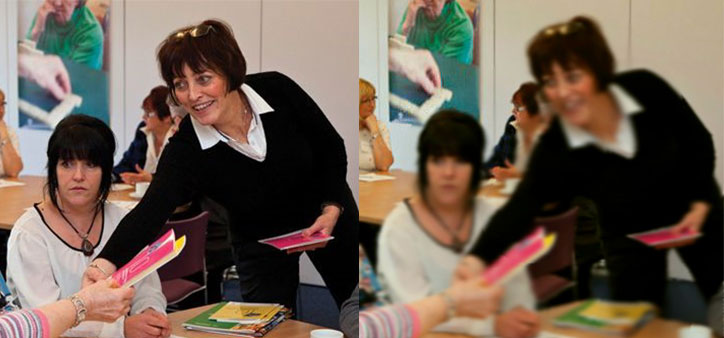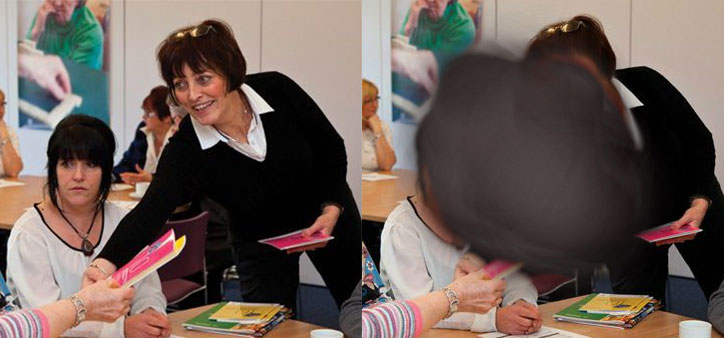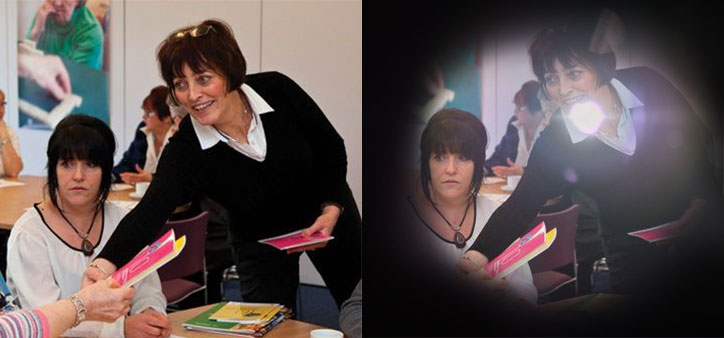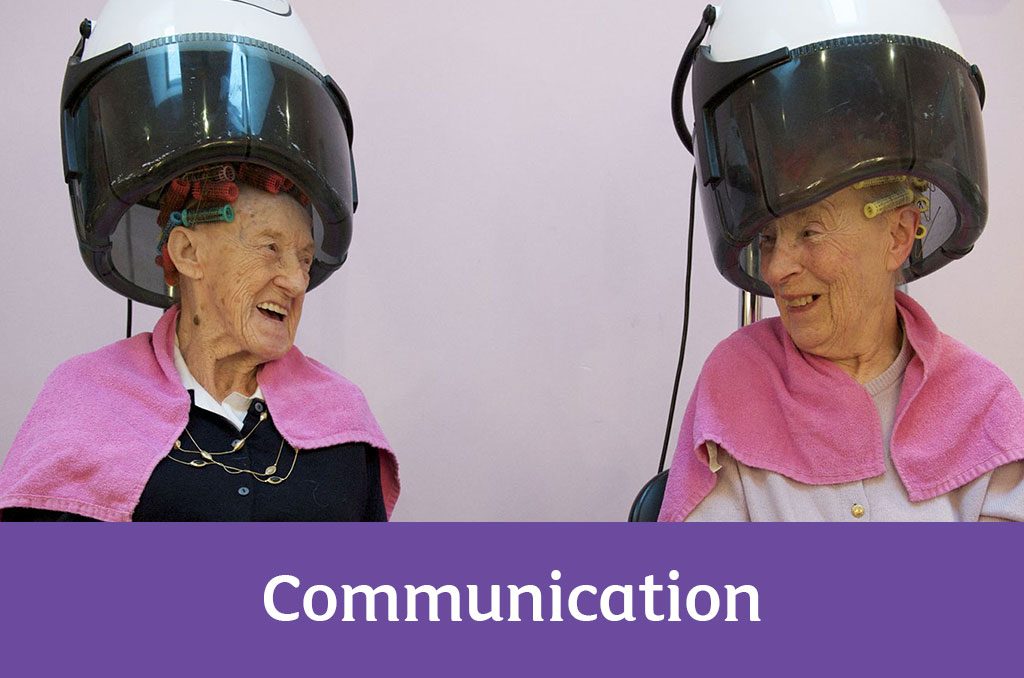The environment

The Impact of the Environment for People Living with Dementia
One of our major focuses here at the Dementia Services Development Centre in Stirling is the impact of the environment on people with dementia.
The following page provides a brief glimpse into some of the aspects of the environment we consider the most important when working with people with dementia. For ease of navigation, we talk about some of the reasons why some environments need to be adapted to help people with dementia maintain their independence in the first section. We then draw from our experience in practice, research, and adaptation to highlight some key issues that can occur at key places within the home, including in the bathroom, kitchen, and bedroom. In each section we highlight one or two examples of what might cause difficulties in each space, and offer a few suggestions of how you might adapt the environment to help. If you have more questions about adapting the environment for someone with dementia, please do not hesitate to contact us.
Before we look at how we can adapt the environment to help the person living with dementia, however, it is important to answer the question of why we should adapt the environment to help the person living with dementia. After all, if the person lives in their own home, shouldn’t we leave it as it is? And if they have moved to residential care, isn’t it already dementia friendly?
The answer to these questions is, unfortunately, probably ‘no’.
The last two decades has transformed how we think about the role of the environment in relation to how it can enable or disable people with dementia. For example, we know now that dementia friendly environments should have limited clutter, while still providing objects which support people with dementia to remember their past. Dementia friendly environments should provide sensory stimulation, but not overstimulate or confuse the person with dementia. They should be adapted to help with changes in a person’s mobility and ability, while remaining familiar… the list might seem endless.
Having all of this information at our fingertips is a wonderful thing, where it provides us with an opportunity to help a person with dementia to age in place, and to remain at home where they wish to… but it can be confusing and overwhelming too. That’s why this page will take it step by step, and remember, if you have any questions please do contact us.
Adapting the Environment for Changes in Memory
“What a numpty I felt tonight! When I was in the kitchen doing my normal routine and I was standing at the kitchen sink looking at the taps. Well, they didn’t look like taps to me anymore. There was, a kinda thing coming up. It looked beautiful, but how on earth was I supposed to switch it on and off?! […]
It wasn’t until my daughter came to visit me and she seen me doing this [carrying water from the bathroom to the kitchen] she says, ‘Mum! What are you doing?’. And I says, ‘I don’t know what they’ve done with the taps in my kitchen. Someone has done something to them. I don’t understand it! I can’t find them’.
And lo and behold, Donna looked at it, and she said ‘Mum, look. It’s a lever, and you push it one way for hot, and push it the other way for cold. Remember this is what you got years ago?’.
And I looked, and I said ‘Really? What a stupid way of turning on taps!’
Donna’s solution was to put a sign that reminds me: Hot, Cold, On, Off. And this is working so far”.
The quote above is taken from Agnes Houston’s dementia diary, and while Agnes is talking about her kitchen here, it perfectly captures something we hear about often at the DSDC: people with dementia finding it difficult to do the things they used to do in their own home.
When we think about the frustration someone with dementia might feel when, for no reason at all, it seems like someone has removed the taps in the kitchen, or hidden all of their clothes where they cannot find them, it isn’t all that surprising to find out that changing the environment of that person can make a significant difference to their quality of life. Adapting a person’s environment can reduce agitation and distressed behaviour, help people be more independent, and improve their quality of life… in Agnes’ case, all for the cost of one sign made by her daughter.
In another dementia diary, Wendy Mitchell talks about her solution to the difficulties she was having finding her belongings. She says:
“[The Kitchen] used to have two doors which really confused me, as closed doors means nothing to me as I can’t remember where they lead, my solution was simply to remove the doors so the stress has gone as I can see where each door leads. I don’t see my wardrobes and kitchen cupboards as they blend into walls. My solution to that was to take photos of the contents and stick them on each cupboard. It’s the photos that attract my attention.”
This is another problem that we hear about fairly often at the DSDC, and what we suggest might change depending on the person. For example, if there is concern someone isn’t eating enough, its important to approach the problem from a number of angles. Does the person know they are hungry? Do they know where to find food, or is it hidden in a cupboard they might not see (as it was for Wendy)? If they find the food, can they find whatever they need to open the packet, the plate or bowl they would use to put it in, and the cutlery to eat it with? If the problem doesn’t appear there, then we ask other questions; can the person see the food on their plate? Do they find it difficult to manoeuvre the cutlery? Or, if we consider the problem more broadly, do they know what time of day it is? Do they know that it is time for lunch, or for dinner? If not, other interventions, like an easy-read clock may help.
The first step, however, is to check that the person remembers what they have, and knows where to find it. This might mean removing doors, or replacing wardrobe and cupboard doors with ones that have glass panels that make the contents visible. It might mean adding labels and instructions to objects- and it might mean experimenting with where those labels are, and what they look like. It might mean sometime else.
The trick here is often time, an open mind, and patience to try small adaptations before stepping up to huge investments. Where you can, it is important to start with the belief that with the right adaptation, the person may well be able to go back to doing some, or all, of what they could do before.
But you don’t know until you try.
Adapting the Environment for Changes in Vision
Although most people with dementia will not experience problems with vision as a result of their dementia, because the majority of adults living with dementia are older, they may also experience a loss of vision or a deterioration of their vision over time.
Below, we’ve created five images to five different conditions that can affect people living with dementia. We use the left hand image to simulate clear, 20/20 vision and provide an easy comparison.
Now think about what might change, if you had one of the following conditions.

In this comparison, you can see the difference between unimpaired vision, and the vision of someone whose eye lens has started to thicken as they age. A thickening lens can often mean that people have difficulty focusing on things that are close to them, but can see objects that are further away more clearly. A thickening lens, then, might impact whether a person continues to read, do jigsaws, sew, or use a tablet- all of which require focusing on things that are close at hand. The treatment for a thickening lens, or presbyopia, is often glasses and an updated prescription.

This comparison shows how it might be to view the world when someone has cataracts. Cataracts are one of the most common causes of vision loss, and occur when the lens of the eye becomes cloudy. Often this causes the world to seem hazy or blurry, but can also cause people to see lights as glaring, which is often noticeable around lamps, on sunny days, or when looking at oncoming headlights in the dark. Cataracts can be treated with surgery.

The image above simulates what it might be like to live with Macular Degeneration. Age Related Macular Degeneration is a term that specifically refers to the process where an older person’s macula (an area of the eye’s retina) begins to deteriorate. Macular Degeneration is a progressive condition that develops over years, and where what might begin as a small area of loss in the centre of the visual field becomes larger over time. As a result, people may struggle to see the faces of those they are speaking to, focus on visual tasks, or know what is in front of them.

This image shows one example of how the world might appear to someone with glaucoma. Glaucoma refers to a group of eye disorders where the damage occurs not at the front of the eye (as with those above) but at the back, at the optic nerve. Glaucoma is often a subtle condition, and few people notice symptoms in the early stages. As the condition progresses, people may slowly lose their peripheral vision, and notice halos and flares around bright light sources as shown above. This can make it difficult for people to navigate, as they might only be able to see straight ahead, and make it difficult for people to know that they are being spoken to, if they cannot see the person talking.

In this final image, you can see example of the effects of hemianopia, a condition that will commonly result in a person losing either one half, or one quarter (such as the upper right corner), of their vision. Hemianopia often occurs after a stroke or other damage to the brain rather than damage to the eye itself. A professional will often recognise Hemianopia, precisely because it occurs alongside a stroke or other injury and can provide further guidance. It is important, however, to consider what a person may not notice because it sits on the side where they have lost their vision. For example, if someone isn’t drinking enough, think about moving the glass to the other side of their plate!
It is important to remember that not all people with dementia will experience a loss of vision in the ways described above. Some, however, will experience difficulties caused by the effects dementia has on their brain. For example, a person with dementia might not have any problem with their vision, but:
- Find it difficult to judge the height of objects, or the height of the floor- leading to exaggerated stepping over objects or up and down stairs.
- Mistake shiny flooring for being wet.
- Find it difficult to find a lost item, even when it is directly in front of them.
Dory reflects on this in her dementia diary she says:
“I’m just doing a diary about what good and bad design means to me with my dementia – the difference it makes with bad design is the difference between me going out or not going out.
For example there’s a cinema near where I live that I would love to just get on the bus in an afternoon and go and watch a film but I just can’t go in because of the floor design. It’s just black and sparkly marble and it’s a vast space so you do have to walk across it to get in and overhead there’s red strip lights which reflect up and there’s no way I can walk across it. So, the design of that … if it was a better design, if it was just a matt finish, then I’d be able to go to the cinema.”
Because the relationship between the eyes and the brain is so complex, a change in vision might be the result of changes caused by dementia, or it might be something that can be addressed directly by healthcare professionals. We recommend always checking with a healthcare professional.
Adapting the Environment for Changes in Spatial Awareness
Many people with dementia will also experience some difficulties with navigating and moving through spaces. While for some people these problems may be related to their experience of their body (i.e., their sense of balance, difficulty judging whether objects are within reach or not) others may become disorientated in familiar places.
This disorientation is one of the difficulties that can be most directly managed through adaptation’s to the person’s environment. Wendy gave one example of this, above, when she talked above removing doors between rooms, so that she didn’t have to rely on her memory to know what was on the other side.
We also advise people who are thinking about adapting the environment to consider what the important items in the area are, and how design can draw attention to them. This may be a slow process, but its better to think carefully before making changes as too many bright or contrasting colours (for example) can cause people with dementia to feel over-stimulated as their brain struggles to distinguish between a lot of different stimuli at once!
It is vital to think about both colour and contrast when designing or adapting a space for people with dementia, as some people may experience certain colours more intensely than they used to, while others may rely more on contrast to make sense of their environment.
If you are interested in learning more, or in seeing how you might adapt someone’s home to be more accessible, consider trying our Iridis app or booking a tour of the Design & Technology Suite within the Iris Murdoch Building (home of the DSDC).
Thinking About Adaptations: In the Bathroom
People often find talking about problems in, and around, the bathroom and going to the bathroom difficult and embarrassing. We understand. We also want to let you know that it is common for people with dementia to experience challenges and anxieties around bathrooms, and that there are ways that design, and adapting the environment, can help.
Let’s consider the following example:
Mr and Mrs A are in their early 60s, and live in their family home. Both Mr and Mrs A are proud of their home, and have spent many years improving each room to be exactly how they want it to be. Mr A has a diagnosis of Alzheimer’s disease.
Some time after Mr A’s diagnosis, Mrs A realises that her husband is no longer reaching the toilet before relieving himself. Instead, he often urinates on the bathroom floor. This happens even when she reminds him to go to the bathroom regularly.
This causes Mrs A significant stress. She begins to try and accompany her husband to the bathroom so that she can direct him to the toilet.
Mr A responds angrily to what he sees as an invasion of his privacy, and often shouts and swears at Mrs A when she attempts to support him in the bathroom.
Mrs A now feels stressed and overwhelmed- not only by the practical problem around her husband’s toileting habits, but his increasing aggression and the strain on their relationship. She seeks help, and receives information about incontinence aids. Early admission to a care home is discussed, as Mrs A feels that she cannot manage her husband’s behaviour.
It is often difficult when we are wrapped up in a problem to take a step back and consider how changing the environment might offer a solution. It might seem in the example above that, short of installing another toilet in the house closer to where Mr A often sits, there is little that can be changed to facilitate Mr A’s toileting.
But, when we remember that dementia can not only affect someone’s memory but the way that their brain works more broadly, it is possible to start asking questions:
- Does Mr A always remember where the bathroom is? If not, is he losing time searching for it, and that causes these accidents?
- Does Mr A have a urinary tract infection?
- Can Mr A find the toilet?
As we’ve already talked about the use of signs and labels, its important to consider the last question. Let’s talk about Mr and Mrs A’s bathroom.
Mr and Mrs A refitted their bathroom 5 years ago.
The room is bright, with plenty of light from the window and strong overhead light at night time. The taps are an older style and easy for Mr A to use.
The white bath, toilet and sink are all set against a soft cream colour wall. Everything is tidied away and there is minimal clutter.
While this design may sound lovely, it provides a key clue to this problem: a lack of contrast.
Many people with dementia need contrast to help them navigate spaces. By having a white toilet, with a white seat, against a light background, the A’s have reduced the contrast available. By introducing contrast, we are able to provide clues to people with dementia.
Remember the red toilet seat, with its high contrast and attention-grabbing colour?
We’ve built this example on a real problem that was brought to us by someone seeking help from the DSDC. In reality, Mrs A had never heard of using contrasting toilet seats to help with bathroom matters, which is exactly what we suggested.
Within a couple of days, we heard from Mrs A again. She called to say that her husband was using the toilet appropriately for the first time in a long time. She no longer had to chase after him to the bathroom. He no longer felt crowded, invaded, and embarrassed. No incontinence aids were needed, and Mrs A confided that the prospect of moving Mr A into residential care had become something to consider in the future- not today. She’d taken the learning even further too- buying a green bar of soap (instead of white) for the sink, and changing the colours of the hand towels to make them easier to see.
One principle- many applications. Real benefit. The impact of adaptive design in practice.
Thinking About Adaptations: In the Kitchen
Another area that can pose difficulty for people living with dementia is the kitchen. In the kitchen, we face all of the issues we have discussed above (difficulty remembering what is hidden behind cupboard doors, shiny surfaces and lack of contrast to name but a few) but with the added dangers associated with sharp knives, hot surfaces, heavy containers, food preparation, gas, and both over and under-eating. The ideas of these risks can lead to significant amounts of stress and worry, for both the person with dementia and for those who support them, even if they haven’t had any difficulties in the kitchen in the past.
At the DSDC, we encourage people with dementia to continue doing the things that have always done, for as long as it is safe to do so. Thankfully, there are a number of environmental changes and technologies that can help someone with dementia continue to use their kitchen as their needs and abilities change. These changes may include continuing to apply the principles we discussed earlier- it may be useful to label cupboards and containers to indicate what they hold, remove cupboard doors disguising the fridge or washing machine and so on.
It may also be useful to consider how the kitchen is arranged, and if it could be changed to help the person with dementia achieve their goal. If you think about how to make a cup of tea there could be up to 16 different steps:
- Have the thought
- Go to the kitchen
- Remember purpose of going to the kitchen
- Fill the kettle
- Turn the kettle on
- Find the teapot
- Find the teabag
- Wait for the kettle to finish boiling
- Fill the teapot
- Find the cup
- Pour the tea
- Find the teaspoon
- Find the sugar
- Find the milk
- Put the milk away
- Drink
If the worktops are less cluttered it can be helpful in promoting or maintaining independence for a person living with dementia: it makes the environment easier to navigate, reminding them what they are in the kitchen for and help support them in maintaining their skills. It’s also worth thinking about where items are positioned to make tasks easier. So, take the tea example again:
- Keeping worktops clear to make key objects easier to find
- Leaving water in the kettle so it is ready to boil
- Keeping the kettle near to the sink, with the tea-making supplies (cups, teaspoons, teabags, coffee, sugar etc.) clearly visible on the counter near
All of the above can be helpful in reminding a person what they are in the kitchen for and help support them in maintaining skills. Once these general principles have been applied to the kitchen, it’s time to think about other specific changes that might make it easier and safer to navigate for someone with dementia. Depending on the person, these changes may require small changes or additions to existing routines (for example, regularly checking the fridge to make sure none of the contents are past their use by date) while others may involve buying specific items to address a particular issue. These products fall into two broad categories, and focus either on supporting someone’s memory impairment or their physical ability.
Read more about the environment for people with dementia through the DSDC resources. If you live in Scotland you can request the 10 Helpful Hint series for free, thanks to funding
Thinking About Adaptations: In the Bedroom
Explore more …





